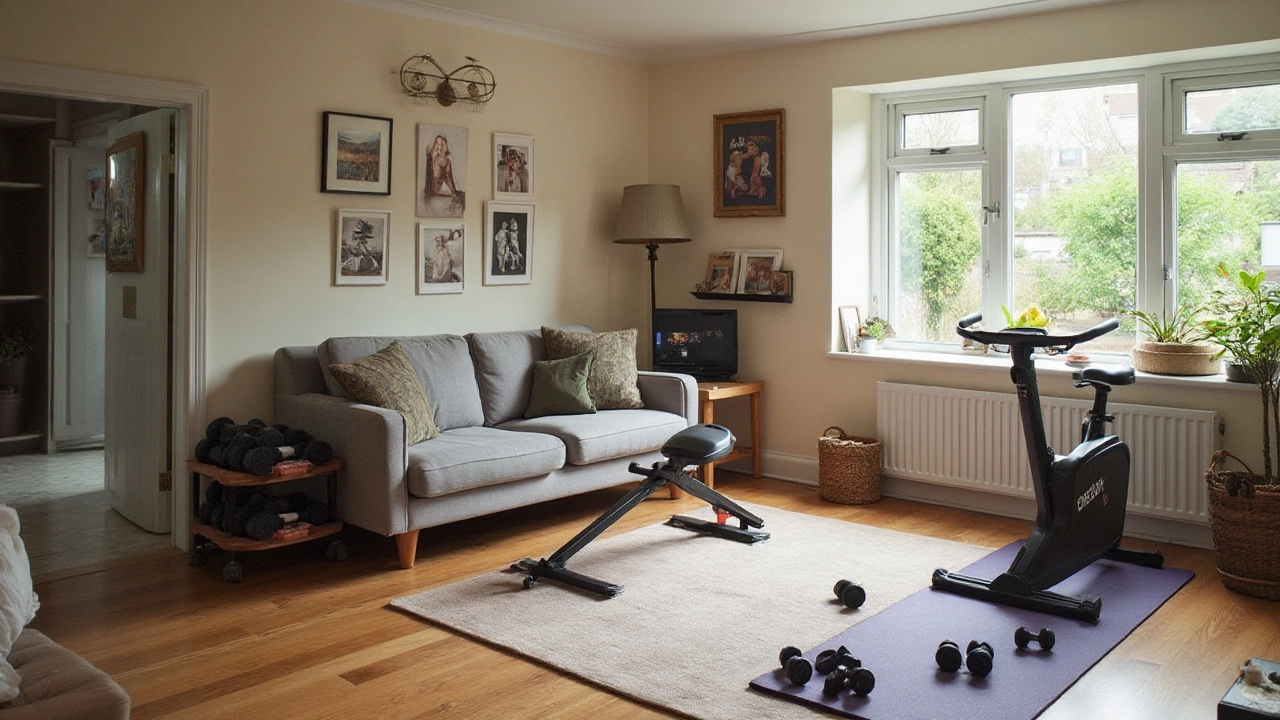
In the bustling world of fitness, determining how long you should spend on your workouts can feel perplexing. With advice ranging from quick 10-minute routines to exhaustive hour-long sessions, it's easy to wonder what truly works best.
There's no one-size-fits-all answer, as the ideal workout duration depends on various factors including your goals, personal health, and how much time you can realistically commit. It's crucial to dive into the reasons behind these recommendations to find a balance that keeps you motivated and brings effective results.
Join us as we unravel the confusion around exercise timings and offer insights to craft a plan that aligns with your lifestyle and fitness objectives.
- Understanding Your Fitness Goals
- The Science Behind Workout Length
- Balancing Time and Intensity
- Tailoring Your Routine to Fit Your Schedule
- Listening to Your Body: The Key to Effective Workouts
Understanding Your Fitness Goals
Embarking on a fitness journey often starts with identifying what you want to achieve. Whether you're aiming to lose weight, gain muscle, or simply improve your general well-being, understanding your fitness goals is the cornerstone of designing an effective workout routine. The goals you set will not only dictate the type of exercises you undertake but also how often and how long each session should last. It's essential to delve into the specifics of your goals and align them with your capacities and lifestyle. Are you preparing for a marathon, aiming to lift heavier weights, or just looking to enhance your cardiovascular health? Each of these aspirations requires different strategies, and understanding them will help you craft a plan that suits your activities and commitments.
Take weight loss, for instance. To shed those extra pounds, you'll want a well-rounded program that combines both cardiovascular exercises and strength training. Experts often suggest incorporating 150 minutes of moderate aerobic activity per week, along with muscle-strengthening activities on two or more days. However, it's crucial to remember that calorie intake plays a significant role in this process. Balancing your dietary habits with your workout duration can accelerate your progress. On the other hand, if your goal is to build muscle, your regimen might flip towards more weightlifting sessions with adequate rest periods between them, focusing on specific muscle groups each day.
General fitness or maintenance often stands as a common goal for many, particularly in this fast-paced, health-conscious era. Dr. William J. Kraemer states, "Consistency is key when it comes to achieving lasting fitness results, more so than intensity."
He emphasizes the importance of establishing realistic and sustainable routines that fit one's personal and professional life, ensuring continuity and effectiveness over time."In this case, individuals often strive for a balanced approach, mixing various forms of exercises and maintaining a moderate level of intensity where workouts serve as a healthy habit rather than a strenuous task.
Moreover, it's not just about what you want to achieve right now, but also about setting a long-term vision. Many people underestimate the impact of having a flexible yet steadfast approach, adaptable to changing circumstances and evolving aspirations. Your fitness journey is dynamic, much like life itself, requiring regular reassessment and tweaking of your workout plan. Sticking rigidly to an initial plan without considering your body's feedback or current life situation can lead to stress, injuries, or even burnout. Therefore, a meaningful understanding of your fitness goals should also include a vision for how you're going to sustain and enhance your health throughout different life stages.
Crafting your workout routine with clear and personalized fitness goals not only keeps you motivated but also provides a roadmap to track your progress. It is the blend of science, self-awareness, and adaptability that leads to success. Whether you are just starting out or looking to refine your current regime, these insights will guide you in establishing practical and inspirational goals that resonate with your desires and realities. Remember, your body is unique, and what works for others may not necessarily apply to you. By tuning into your needs and preferences, you can pave your own path towards wellness and vitality.
The Science Behind Workout Length
Deciding how long to exercise isn't just about clocking in time at the gym; it's about understanding how your body responds to physical activity. Various scientific principles help dictate the optimal workout duration, balancing intensity and rest to ensure optimal results. Exercise physiologists have long studied how duration affects performance, recovery, and progression. They have found that whether you're aiming for weight loss, muscle growth, or simply maintaining health, understanding your body's needs is key. The science behind these choices involves balancing energy systems, monitoring heart rates, and understanding the role of rest and intensity. This means whether you're engaging in a low-impact jog or high-intensity interval training, the time you spend on each matters.
Exercise can generally be categorized based on whether it targets the aerobic or anaerobic system. Aerobic workouts, like swimming or jogging, rely on oxygen and are typically longer sessions, ranging from 30 minutes to an hour. These activities enhance cardiovascular health and endurance. Anaerobic exercises, such as weightlifting or sprinting, tend to be shorter in duration yet intense, often lasting under 30 minutes. Here, the focus is on muscle building and strength due to quick bursts of energy. Knowing the science behind these energy systems not only helps tailor your routine towards your goals but also prevents burnout or injury.
The heart rate plays a crucial role in determining the effectiveness of your workout plan. By working at the right intensity, you can make the most of each session. Moderate-intensity workouts should typically keep your heart rate between 50 to 70 percent of your maximum, while high-intensity sessions go above 70 percent. Understanding these zones can be particularly beneficial for those looking to improve athletic performance or manage body weight.
"The American Heart Association recommends at least 150 minutes of moderate aerobic activity or 75 minutes of vigorous activity each week," notes Dr. Jason Karp, an exercise physiologist and coach.
Time invested in working out also interacts with rest and recovery periods. Overworking muscles without sufficient recovery can lead to fatigue and plateaued progress. Thus, rest is not a sign of weakness but rather a crucial component of an effective routine. Sufficient recovery allows for muscle repair and strength gains. Scheduling rest doesn't necessarily mean inactivity; active recovery through light activities like yoga or walking can enhance flexibility and circulation. Hence, balancing exercise intensity with adequate downtime transforms your routine from a chore into an enjoyable and sustainable habit.

Balancing Time and Intensity
When it comes to crafting a workout routine, finding the right balance between the duration and the intensity of your sessions is essential. This balance directly influences your results, whether you're targeting fat loss, muscle building, or improving overall fitness. Short, high-intensity sessions, like those in High-Intensity Interval Training (HIIT), can be just as effective, if not more, than longer sessions at steady pace. HIIT workouts, which got popular in recent years, use bursts of intense activity followed by rest or lower-intensity exercise. Studies have shown that these can improve cardiovascular fitness and boost endurance. The American College of Sports Medicine suggests that a HIIT workout could take from 20 to 30 minutes, offering a compact yet effective option for those with limited time.
On the other hand, if you're someone who finds solace in longer, low-intensity workouts, such as jogging or cycling, you might be wondering if you're losing out on benefits. Not necessarily. While low-intensity exercises might take more time, they help build stamina, improve mental health, and are ideal for those just starting out. It's also important to consider recovery time, as longer workouts often require longer rest periods, a factor that is crucial as it prevents injuries and boosts long-term success. When planning your routine, it may be beneficial to alternate between short and high-intensity sessions and longer, moderate ones for a well-rounded approach to fitness.
Besides time and intensity, keep in mind your personal preferences. After all, a routine you enjoy is more sustainable. Some people thrive in morning workouts, starting the day with a surge of energy, whereas others find evening workouts help them unwind after a long day. Tailor these insights to fit your life and preferences, which will make it easier to stay consistent. As fitness expert Jillian Michaels puts it,
"Find the type of exercise that makes you feel strong and empowered, rather than drained and exhausted."Your workout should be something you look forward to, not dread. Discovering the right equilibrium can transform your approach and results, ensuring you stick with it for the long haul.
Tailoring Your Routine to Fit Your Schedule
In our fast-paced world, finding the perfect balance between life’s demands and a consistent workout routine can sometimes feel like juggling flaming torches while riding a unicycle. The challenge of making exercise a priority amidst work, family, and social commitments is real, yet not insurmountable. Understanding the magic formula to integrate a workout routine seamlessly into your daily schedule requires creativity, flexibility, and a bit of strategic planning.
Let’s start with the fact that every individual's schedule varies significantly, and acknowledging this is the first step. For some, mornings might offer a serene time to focus on fitness without distractions, often reaping the benefits of starting the day with a burst of energy. For others, evenings may provide a quiet escape, a chance to unwind and reflect as they move through their exercises. It's essential to identify your rhythm and choose a time slot when you're most likely to commit consistently.
One effective method to ensure consistency is aligning your workouts with regular activities, such as watching television or waiting for dinner to cook. Carving out time while engaging in these passive activities can make all the difference. Imagine doing a quick circuit while catching up on your favorite show or stretching as dinner simmers. This multitasking approach can cleverly integrate the ideal fitness routine without feeling like you’re adding more to your plate. Benjamin Horne, a fitness expert, often advises,
"Couple your workouts with daily routines you enjoy. It's not about finding time, but making it."
Moreover, technology offers a phenomenal range of solutions to aid your quest for balance. Fitness apps with personalized plans, online workout sessions that you can squeeze into any tight gap, and digital reminders can all act as trusty companions. These tools not only guide you through effective exercises but also provide motivation and convenience by meeting you where you are, anytime and anywhere. With these resources, it's easier to prioritize your workout within a busy day, ensuring that your health never takes a back seat.
However, flexibility remains a key part of tailoring your exercise regime. Life can be unpredictable, and strict adherence to a rigid workout time slot might lead to frustration and burnout. Instead, allow for some elasticity; if you miss your planned morning jog because of an unexpected meeting, consider a brisk walk during lunch or a quick evening session. Remember, the goal is to be active regularly over perfection. Achieving your fitness goals is less about the number of minutes spent and more about consistency over time. Choosing a routine that fits your exercise time preferences is crucial in ensuring long-term adherence.

Listening to Your Body: The Key to Effective Workouts
Getting an effective workout often begins with understanding the signals your body sends. Though fitness plans often emphasize structure, your body is not a machine that conforms to rigid routines. It's essential to develop a keen sense of awareness towards what your body is communicating each day. This is where the true art of fitness lies, transcending mere sets and reps. By listening, you can avoid overtraining, reduce the risk of injury, and maintain a longer, sustainable fitness journey.
Let's delve into the complex language your body speaks. Imagine waking up one morning, and you feel that extra ounce of fatigue. Perhaps, last night’s sleep wasn't optimum, or you're coming down with something. Instead of pushing through the workout just because it's 'on the schedule,' consider moderating the intensity or even opting for a rest day. The body needs time to recover and strengthen itself after exertion. Ignoring these signs can lead to longer-term concerns, such as chronic fatigue or stress injuries. Fitness experts often argue that a workout's success isn't solely based on pushing harder; it's about finding the right balance.
"Train hard, but recover harder," says renowned fitness coach Mike Reinold. This is sage advice for anyone looking to make fitness a part of their lifestyle, not just a temporary goal.
Your mind can be a valuable ally or a mischievous adversary in the gym. Your mental focus and state can significantly impact the quality of your workout duration. On days you're feeling mentally drained, it might be wise to adjust your routine. Deloading or switching to a light cardiovascular session can sometimes reignite your passion for working out. Engaging in a mindful practice, such as yoga or pilates, offers a low-intensity alternative that still brings multiple benefits. Prioritizing your mental well-being alongside physical activity can help ensure that both remain in sync.
There’s substantial evidence supporting the need to adapt workout intensity to individual needs. Researchers consistently find that a one-hour session may not be suitable for everyone. Muscles grow and repair most during rest periods post-exercise. As tempting as it is to follow a friend's rigorous regimen, the truth is each person's physiological makeup determines how they respond to exercise. Incorporating rest days and enjoying them guilt-free is an overlooked aspect of athletic advancement. Modern fitness paradigms are gradually shifting toward this understanding, favoring longevity and consistency over short-lived intensity.
Finally, monitoring your heart rate and comparing it against known healthy ranges can provide a tangible measure of how your body is handling physical stress. Today's workout technologies can assist in this, offering insightful data on your performance and recovery status. Heart rate monitors can be incredibly revealing; they can help identify when you’re overstriding or need more cardio endurance. For serious athletes, tracking variability in heart rates can showcase when the body is under undue stress, advocating for necessary alterations in the programmed exercise time.
In the pursuit of fitness, bear this in mind: your body is unique, designed exceptionally for your path alone. By tuning into its wisdom, your exercise journey becomes more intuitive and, ultimately, more rewarding. Indulge in its feedback, and you'll find a lifelong partnership between effort and rest, strength and recovery. So, as you lace up for your next workout, remember, achieving your fitness milestones doesn't always mean pushing harder. Often, the key to enduring success lies in listening to the rhythm of your own body.
